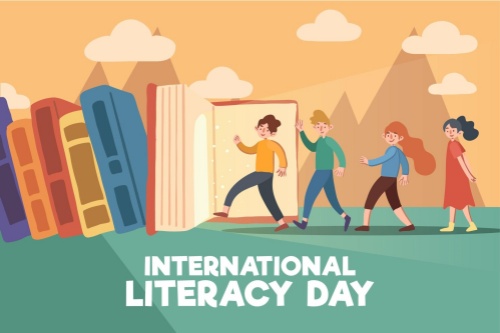
Message from Ms. Audrey Azoulay, Director-General of UNESCO, on the Occasion of International Literacy Day文章源自英文巴士-https://www.en84.com/14857.html
教科文组织总干事奥德蕾·阿祖莱国际扫盲日致辞文章源自英文巴士-https://www.en84.com/14857.html
文章源自英文巴士-https://www.en84.com/14857.html
8 September 2023文章源自英文巴士-https://www.en84.com/14857.html
2023年9月8日文章源自英文巴士-https://www.en84.com/14857.html
文章源自英文巴士-https://www.en84.com/14857.html
“Once you learn to read, you will be forever free” wrote the American abolitionist – and former slave himself – Frederick Douglass.文章源自英文巴士-https://www.en84.com/14857.html
文章源自英文巴士-https://www.en84.com/14857.html
“一旦学会阅读,便可永获自由。”美国废奴运动领袖、自己也是奴隶出身的弗雷德里克·道格拉斯这样写道。文章源自英文巴士-https://www.en84.com/14857.html
文章源自英文巴士-https://www.en84.com/14857.html
Literacy is indeed much more than merely learning letters and words. It transforms the drops of ink on paper into windows on the world; it is the key that opens the door to knowledge, emancipation and imagination.
扫盲不仅仅是学会拼读识字,更是将落在纸上的墨迹转变成通向世界的窗口。扫盲也是打开知识、自由和想象之门的钥匙。
Beyond the benefits for the individual though, society as a whole benefits from progress in literacy. For it is a passport to communication with others, thereby strengthening understanding within and between peoples; and it also enables everyone to integrate into society and strengthens participation in civic life.
扫盲的进步不仅使个人受益,也惠及整个社会。因为通过扫盲,可以与他人沟通交流,也因此能够增进人民内部和各国人民之间的理解。扫盲还会使每个人都能融入社会并深入参与公民生活。
In the space of 40 years, significant progress has been made: 3.6 billion people have learned to read and write, raising the global literacy rate from 68% in 1979 to 86% in 2020.
过去的40年已经取得了长足进展:36亿人学会了读写,全球识字率从1979年的68%上升到2020年的86%。
However, the current situation is still rife with injustice and inequality. At the halfway point in the 2030 Agenda for Sustainable Development, 244 million school-age children are still not in school, 98 million of them in sub-Saharan Africa. At the same time, 773 million adults still cannot read or write – two thirds of them women.
然而,目前的局势下仍然充斥着不公正和不平等。《2030年议程》已过半,却仍然有2.44亿学龄儿童失学,其中9800万儿童在撒哈拉以南非洲。与此同时,7.73亿成年人仍然不会读写,其中三分之二是妇女。
Over and above illiteracy, learning gaps still too often lead to incomplete literacy: six out of ten children attending school at the age of ten cannot read and understand a simple text.
不止是文盲问题仍然存在,学习上的差距还常常导致扫盲不彻底:在10岁的在校儿童中,有六成不能阅读和理解简单的课文。
That is why, then as now, UNESCO supports literacy efforts in countries all over the world. And we pay particular attention to crisis situations, where the fundamental right to learn to read and write is under threat.
正因如此,教科文组织过去和现在都在世界各地支持各国的扫盲工作。我们还特别关注危机局势,因为在危机局势中,学习读写的基本权利面临着威胁。
This is the case in Afghanistan, where UNESCO has led a major literacy campaign benefiting 1.2 million young Afghan men and women since 2008.
阿富汗的情况就是如此,自2008年以来,教科文组织在那里开展的大规模扫盲运动,已使120万阿富汗青年男女受益。
In the past two years though, as the de facto authorities have denied Afghan women and girls over the age of 12 their fundamental right to education – a ban that has been extended to higher education since December 2022 – this progress has been in serious jeopardy and so, on this symbolic day, UNESCO is once again calling for the right to education for all women and girls to be restored, without delay.
但在过去两年里,事实上的管辖当局剥夺了12岁以上的阿富汗女性接受教育的基本权利,并且自2022年12月以来这一禁令已延伸至高等教育领域,致使阿富汗已经取得的扫盲进步面临严重威胁。为此,在这一具有象征意义的国际日,教科文组织再次呼吁毫不拖延地恢复所有女性的受教育权。
If literacy is a victory for humanity, it is a fragile one: there is always the possibility of a relapse. Let this International Literacy Day be a reminder of this – and an opportunity to honour all those who are dedicated to making universal literacy a reality, not just a goal.
扫盲固然是人类的一项成就,但那是一项脆弱的成就:倒退现象随时可能发生。值此国际日,让我们铭记这一点,并向所有那些致力于使全民扫盲成为一个现实而不仅仅是一项目标的人们致敬。

